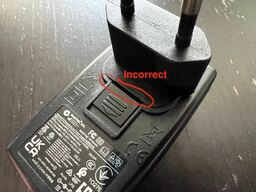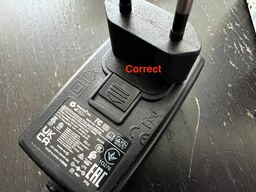# nodl box quick start guide
Applies to:
nodl One (black, etched logo) and nodl Dojo (red, etched logo)
# Thank you for purchasing our product!
Below are a few instructions to help you setup the device.
# What’s in the box?
- A piece of paper with very important passwords on it, as well as your nodl's unique name - DO NOT TRASH (optionally sent by PGP encrypted email if you selected this option)
- The nodl
- A power supply (4A for nodl One, 6A for nodl Dojo)
- A European/American/British/Australian (Dojo only) plug (depending on your region)
- A set of rubber feet and a micro SD reader (Dojo only)
- An Ethernet cable
- Some stickers and/or other stuff
# Step 1: Connecting all the things & powering on
Your network has to have an available Ethernet port and run DHCP (automatic address assignment). This is most probably the case.
Connect the Ethernet wire to your router or switch and to the nodl. If you don’t like the length, color or both, you can use any wire you have.
Connect the power supply to the nodl. If your power supply plug is European, make sure the lock is latched properly as shown below.


You should see lights. Depending on your device, you'll see a backlit logo on top (red for Dojo, blue for One - only if kill switch option is installed).
Check that the lights near the Ethernet (network) cable blink. Green (left) should be steady or slowly blinking, orange (right) should blinking with the traffic going in and out.
# Step 2: Setting the password
Point your favorite browser to the address written on the included welcome paper.
Sometimes, computers can't resolve ".local" addresses. This happens mostly with Windows but also with some very custom Linux distributions.
In this case, you may have to go to your router's web interface to find nodl's IP address and use https://ipaddress/ instead.
If you can't find the address or nothing happens when you enter the address, check that your nodl is properly connected to the same network as your computer and not a secondary switch / router.
Click on the nodl logo.
Enter a password (twice). The only requirement is the length (12 characters minimum) but use something strong as this password will allow you to reveal the connection information for the lightning node (and allow to transfer funds out of it).
Click on “click here”, you should see the status page with application tiles.
The nodl performs an automatic upgrade as soon as you define the password to make sure that you're running the latest version of the software.
# Step 3: Syncing up
The device is kept synced to the blockchain until it leaves our kitchen. Depending on the time it stays in the box, it will require more or less time to be synced again. If the % of sync doesn't move after 10-15 minutes, check the troubleshooting guide.
To access settings, enter the password defined at step 2 in the password field on top.
While syncing, you can install additional services (Tor, Bitcoin core, Dojo and Electrs come pre-installed and pre-synced).
# Additional optional and recommended steps
# Connect Zap Desktop, Zeus, ...
Once lnd is installed, instructions for connecting Zap Desktop and Joule will automagically appear on in the lnd tile on the nodl interface.
# Optional: Install BTCPay Server
After your nodl is fully synced, you can proceed with installing BTCPay using the same method. BTCPay is built from source and it takes some time (up to 20 minutes).
# Recommended: Join our support channel on Telegram or Slack or both
# Appreciated: Shill the nodl on twitter
Take a picture and tag our Twitter account 😃
# Recommended: Keeping the software up to date
For privacy reasons, we don’t push updates and there is no auto-update mechanism (yet). It’s up to you to keep your nodl updated by pressing the “Upgrade nodl” button from time to time.
The nodl will then retrieve the latest software from a git repository and run its update script.
#Happy nodl-ing !